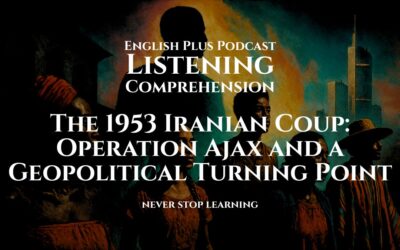Introduction
Welcome to this listening practice session designed for international exam preparation. Today’s exercise focuses on the cultural significance of the Great Wall of China. As you listen, pay close attention to the narrator’s tone, transitional phrases, and descriptive language. Notice how details and historical context help build the narrative. A useful tip is to underline key descriptive words and note shifts in perspective, which can help you answer questions accurately during exams such as the SAT, TOEFL, and IELTS. Enjoy the narrative and remember that each detail you catch contributes to a richer understanding of both history and language.
Listening Practice
Listening Script: Please don’t read the script before you listen and take the quiz
The Great Wall of China stands not only as a monumental feat of ancient engineering but also as a living symbol of the enduring spirit of a nation. For centuries, this iconic structure has inspired awe and admiration, serving as a testament to the ingenuity and determination of the Chinese people. As you listen to this narrative, imagine the vast expanse of the wall winding its way over mountains, valleys, and deserts, each stone telling a story of perseverance and cultural pride.
Historically, the Great Wall was constructed over several dynasties, beginning as early as the 7th century BC and reaching its peak during the Ming Dynasty. Its primary purpose was to serve as a defense against invasions, yet its cultural significance far exceeds its military origins. Over time, the wall became a symbol of unity and resilience, representing the collective efforts of countless workers and military strategists. The wall’s imposing structure and extensive reach made it a formidable barrier, but it also evolved into a bridge that connected diverse regions and cultures within China.
As the wall traverses various landscapes, it intersects not only physical terrains but also cultural and historical narratives. In rural villages near the wall, local legends and folklore have emerged, blending historical facts with mythical elements. These stories speak of ancient battles, heroic defenders, and mysterious guardians who watched over the land. The wall, in this context, is not merely a relic of the past; it is an active participant in the cultural memory of the people. It reminds them of a time when community and honor were paramount, and every stone contributed to a larger story of survival and unity.
The Great Wall has also played a significant role in shaping Chinese art and literature. Poets, painters, and writers have long been captivated by its majestic presence, often using the wall as a metaphor for endurance, separation, and the passage of time. Traditional Chinese paintings capture its serpentine curves against a backdrop of dramatic skies, while classical poems evoke feelings of nostalgia and longing. These artistic expressions serve as a bridge between the tangible structure and the intangible emotions it inspires, reinforcing the wall’s status as a cultural icon.
Beyond its artistic influence, the Great Wall has become a focal point for cultural exchange. Over the centuries, travelers from distant lands have journeyed to witness this wonder, bringing with them their own traditions, languages, and worldviews. The interaction between local communities and foreign visitors has enriched the cultural tapestry of the region, fostering an environment of mutual respect and curiosity. In modern times, the wall attracts millions of tourists each year, each visitor contributing to a global dialogue about history, heritage, and the human spirit.
Educationally, the Great Wall offers a unique opportunity for learning. It stands as an open-air classroom where history, architecture, and cultural studies converge. Students and scholars can explore its construction techniques, analyze the strategic planning behind its design, and reflect on its impact on Chinese society. This immersive experience encourages critical thinking and helps learners appreciate the complexities of historical narratives. Moreover, the wall’s continued preservation and the ongoing research about its origins serve as a reminder of the importance of safeguarding cultural heritage for future generations.
In addition to its historical and educational value, the Great Wall represents a source of national pride. For many Chinese, it is a physical manifestation of their ancestors’ relentless pursuit of excellence and their determination to overcome adversity. The wall stands as a silent witness to the triumphs and tribulations of a civilization that has weathered countless storms. Its enduring presence is a powerful symbol of hope and resilience, instilling a sense of identity and belonging in those who call China home.
The modern significance of the Great Wall is multifaceted. On one hand, it functions as a major tourist attraction, contributing significantly to the local economy and promoting international cultural exchange. On the other hand, it poses challenges related to preservation and sustainability. As millions of visitors traverse its ancient pathways, the delicate balance between conservation and accessibility becomes a pressing concern. Efforts to restore and maintain the wall are ongoing, involving both government initiatives and local community participation. These efforts highlight the complex relationship between cultural preservation and modern development.
Furthermore, the Great Wall continues to inspire contemporary cultural expressions. Modern filmmakers, novelists, and artists draw upon its imagery to create works that resonate with audiences worldwide. Its silhouette against the setting sun, its rugged contours, and its storied past serve as potent symbols in visual arts and popular culture. In doing so, the wall transcends its physical form and becomes an integral part of the global cultural lexicon. It embodies the timeless themes of struggle, resilience, and unity that are relevant not only in China but also across diverse cultures.
As we reflect on the cultural significance of the Great Wall, it becomes clear that its value extends far beyond its physical structure. It is a repository of collective memory, a source of artistic inspiration, and a living monument to the human spirit. The wall invites us to consider the ways in which history is preserved, celebrated, and transformed over time. It challenges us to look beyond the surface and to appreciate the intricate layers of meaning embedded within each brick and stone.
In conclusion, the Great Wall of China is far more than an ancient fortification. It is a dynamic symbol of cultural identity, historical continuity, and artistic expression. Its legacy is woven into the fabric of Chinese society and continues to influence global perceptions of heritage and resilience. By exploring its multifaceted significance, we not only learn about the past but also gain insights into the values and aspirations that continue to shape our world. This narrative encourages us to engage deeply with history, to listen to the stories of the past, and to carry forward the lessons of unity and perseverance into our own lives.
Keywords and Phrases for Advanced English Learners
Cultural Significance:
The importance of a cultural artifact in representing the values, beliefs, and history of a society. In our script, the Great Wall symbolizes unity, resilience, and the historical spirit of China.
Architectural Marvel:
An extraordinary building or structure recognized for its design and engineering. The Great Wall is described as a monumental feat that has inspired awe for centuries.
Historical Legacy:
The lasting impact of historical events or structures on contemporary culture. The narrative highlights how the wall connects past achievements with modern cultural pride.
Cultural Exchange:
The mutual sharing and blending of cultural practices between different societies. The script illustrates how international visitors have enriched local traditions around the wall.
Folklore:
Traditional stories and legends that are passed down through generations. Local legends surrounding the Great Wall add depth to its cultural narrative.
Heritage Preservation:
The act of protecting and maintaining cultural artifacts for future generations. The ongoing efforts to restore the wall exemplify this commitment.
Open-Air Classroom:
A real-life environment used for educational purposes, where learners can engage directly with history. The wall is portrayed as a dynamic venue for learning.
Metaphor:
A figure of speech where one thing is described in terms of another to highlight similarities. The Great Wall serves as a metaphor for endurance and unity in Chinese art and literature.
Resilience:
The capacity to recover quickly from difficulties; a quality of strength. The script emphasizes the resilience of the Chinese people through the enduring legacy of the wall.
Collective Memory:
The shared pool of memories and experiences held by a community. The stories and legends associated with the Great Wall contribute to the collective memory of a nation.
Each of these keywords is integral to understanding the script’s narrative and enriching your advanced listening skills. By familiarizing yourself with these terms, you will be better equipped to grasp the deeper cultural and historical nuances discussed in this exercise. Enjoy your practice and keep exploring new dimensions of language and history!










0 Comments